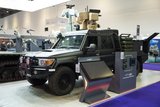LandWarNet 2011: US Army calls for more realistic NIE
The US Army's Network Integration Evaluation (NIE) lacks sufficient realism in relation to ongoing operations in Afghanistan, senior service officials have admitted.
The bi-annual exercise which takes place at Fort Bliss and White Sands Missile Range, New Mexico, is designed to recreate the tactical network and includes operational tests of Programmes of Record and emerging technologies.
The next test for NIE 12.1 is scheduled to take place in October and will include the integration of full motion video (FMV), aerostats and surveillance towers.
However, speaking at the LandWarNet conference in Tampa, Maj Ryan Lueders, Program Executive Officer for Intelligence, Electronic Warfare and Sensors, conceded that despite the introduction of more and more sensors and platforms, there was still a requirement for a 'more robust scenario and OPFOR [opposing force]'.
Describing the test exercise as being 'similar' to the Afghanistan theatre, the army's Deputy Program Executive Officer for Integration Col John Wendel, also stressed how NIE required 'better access to COTS [commercial off-the-shelf] equipment so that we can spin it and get it out to the field as soon as possible'.
Referring to lessons learned in previous tests, Leuders said platforms such as the Persistent Threat Detection Systems would not be included in the October programme but suggested that Persistent Ground Surveillance Systems could be brought in. 'How do we test without pieces of infrastructure,' he asked while stating that the programme had yet to reflect all the equipment requested by troops in training.
'There are too many systems under evaluation and networks with no collective training or TTPs [tactics, techniques and procedures] for collective employment and we're really not sure how new technology is going to change the battlefield,' Leuders continued.
Army officials added that the NIE process still required increased planning, execution and network management; less time spent grooming system to ensure they meet performance objectives; and more quantity of products capable of supporting testing. and earlier 'lock-down' of systems under evaluation which was described as a 'key decision' in the development of the network architecture. The process was also criticised for 'slipping' key milestones.
More from Digital Battlespace
-
![Babcock nears first customer for Nomad AI translation tool]()
Babcock nears first customer for Nomad AI translation tool
Nomad can provide militaries with real-time intelligence, saving critical time on the battlefield.
-
![AUSA 2025: Israel’s Asio Technologies to supply hundreds of improved Taurus tactical systems]()
AUSA 2025: Israel’s Asio Technologies to supply hundreds of improved Taurus tactical systems
Taurus operates alongside the Israel Defense Forces’ Orion system which supports mission management across tens of thousands of manoeuvring forces, from squad leaders to battalion commanders.
-
![AUSA 2025: Kopin pushes micro-LED plans as China moves faster]()
AUSA 2025: Kopin pushes micro-LED plans as China moves faster
The plan for the new displays follows fresh investment in Kopin’s European facilities by Theon and an order for head-up displays in fielded aircraft, with funding from the US Department of Defense.
-
![AUSA 2025: Persistent Systems to complete its largest order by year’s end]()
AUSA 2025: Persistent Systems to complete its largest order by year’s end
Persistent Systems received its largest ever single order for its MPU5 devices and other systems earlier this month and has already delivered the 50 units to the US Army’s 4th Infantry Division.
-
![Aselsan brings in dozens of companies and systems under the Steel Dome umbrella]()
Aselsan brings in dozens of companies and systems under the Steel Dome umbrella
Turkey has joined the family of countries attempting to establish a multilayered air defence system with government approval in August 2024 for the effort landed by Aselsan. Dubbed Steel Dome, the programme joins Israel’s Iron Dome, the US Golden Dome, India’s Mission Sudarshan Chakra and South Korea’s low-altitude missile defence system.
-
![DSEI 2025: MARSS unveils new agnostic multidomain C4 system]()
DSEI 2025: MARSS unveils new agnostic multidomain C4 system
MARSS’ NiDAR system has been deployed using sensors from static platforms to provide detection and protection for static sights, such as critical infrastructure, ports and military bases.



























